
Untying the Knot of Human Heart Formation: Your Heart is a Double Helix Spiral, Unfolds Along Embryo Heart Folding Patterns
Untying the Knot: Your Heart is actually a Spiral
Medicine, Professional Portfolio, Science
The heart is, “an arrangement so unusual and perplexing,
that it has long been considered as forming a kind of Gordian knot in Anatomy.
Of the complexity of the arrangement I need not speak further than to say that
Vesalius, Albinus, Haller and De Blainville,
all confessed their inability to unravel it”.
–James Bell Pettigrew, 1834-1908
Unfolding the Heart
If anyone suggests to you that science, particularly biological science and medicine, is not beautiful and not much more than “a dissection”, as someone once said to me, I could offer you a place to begin… a place of great beauty to point to.
It is one of the fascinating details of evolutionary embryology that I loved learning as a student: the vertebrate heart evolved from a single simple tube into the complex structure we know as our heart. Here is the heart of a human embryo before two weeks:

Tubular heart of human embryo before 14 days.

Human embryonic heart. 14 day old.
Here is great old animation depicting the human heart formation:
Circulation functions with a “two-chambered” heart in fish, as you can see in this illustration:
“Two-chambered” heart of fish.
![]()
It is a three-chambered in amphibians and reptiles. And it is four-chambered in mammals and birds.

Four Chambered Adult Human Heart. Illustrated by Laura Maaske.
For further comparison, visit these pages which offer comparative imagery: Fish, amphibian, and mammalian hearts, and Fish, amphibian, reptile, and mammal & bird hearts.
During my undergraduate coursework in zoology, this evolution had stuck me as beautiful, that organisms tend towards complexity in their evolution. Later, as a student in biomedical communications at the University of Toronto, I found heart dissections reveal beautifully complicated anatomy compared to what I’d seen in the fish just a few years before.
In fact, while embryologists understood this folding pattern by observing cardiac development, it wasn’t until 2006 that the anatomist Torrent Guasp, using a special technique, dissected the human heart for the first time in history. In this skillful dissection he uncovered the original embryonic tube structure. Here is a video explaining Torrent Guasp’s dissection:
“When I looked at the heart for the first time I saw a circumferential basal loop. And then I saw a descending limb and an ascending limb. And they curl around each other at a helix and a vortex, except for the ventricle. And the angles at which they go is about 60 degrees. 60 degrees down and 60 degrees going up, and they cross each other in that way. For years people had wondered why this happened. I realized this is really a spiral. And I began to think about spirals. And I began to understand that spirals are almost the master plan of nature in terms of structure and in terms of rhythm.… if you pick the middle of the spiral up you form a helix. And of course the heart is a helix.”
-Dr. Gerald Buckberg, M.D.
So, for one of my own favorite illustration projects, I began my work by researching this folding pattern, and drawing its reach into the heart. As you can see, the folding works a little bit like a knot, and it is also a two-ended spiral.

The folding structure of the heart
I made a sample out of clay and practiced the folding pattern.

I made a sample out of clay and practiced the folding pattern.


And here are my illustrations to reveal the tubular unfolding pattern of the human heart:
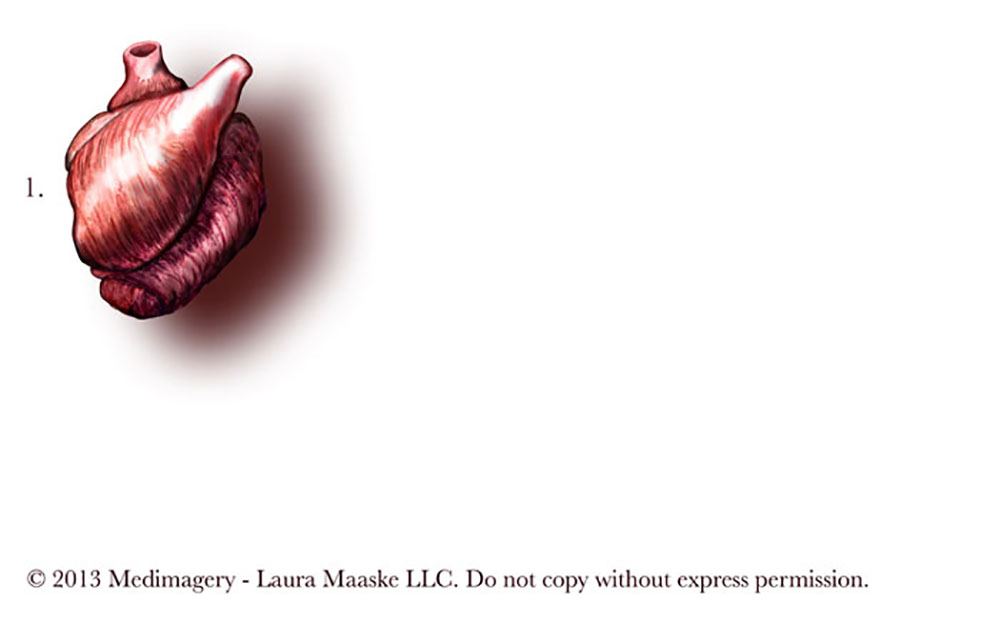
Unfolding the Heart 1 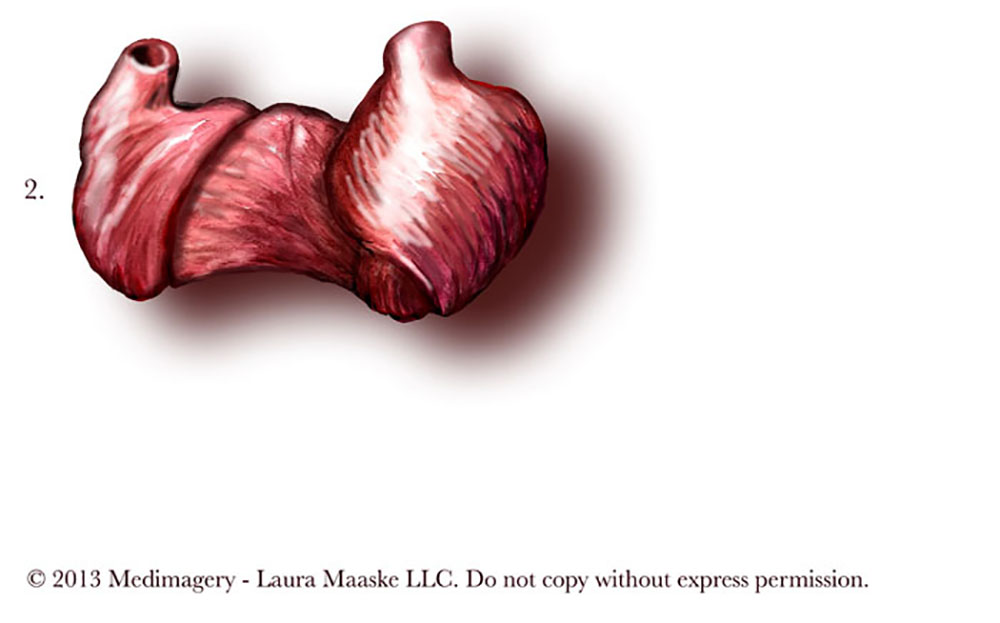
Unfolding the Heart 2
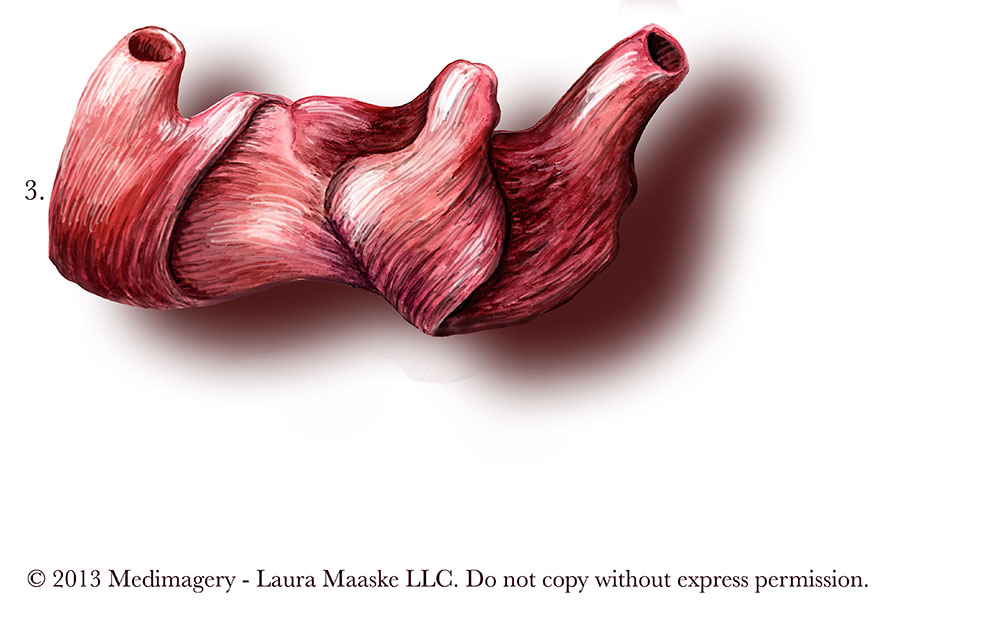
Unfolding the Heart 3 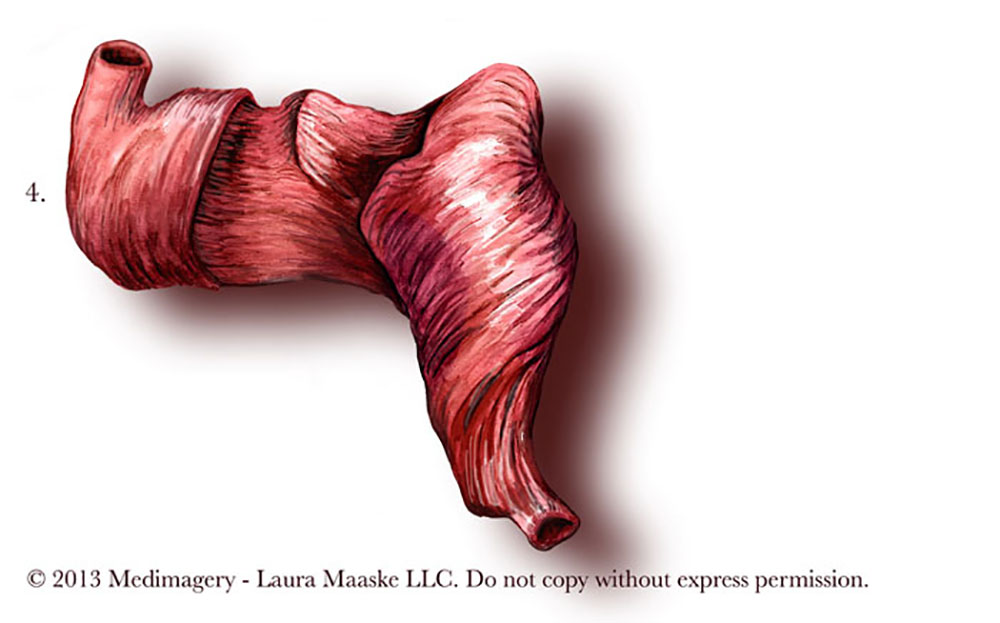
Unfolding the Heart 4 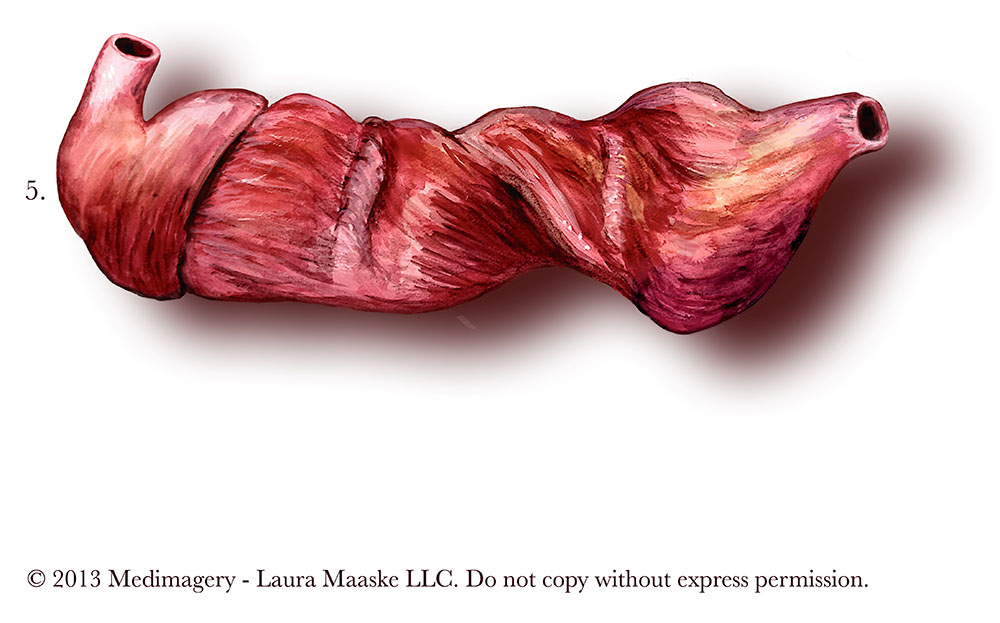
Unfolding the Heart 5
[smartslider3 slider=7]
As you can see in these illustrations, the adult human heart in its evolved form is a flattened tube, and behaves like a rope as the muscles wrap and squeeze blood. But it is a very complex knot, the dissection of which was not even achieved until the past few years, with Torrent Guasp. How remarkable that a structure so complex can be reduced, backwards, so that its simpler origin is apparent.
October 29, 2013
Laura Maaske, B.Sc., M.Sc.BMC, Medical Illustrator & Designer
Biomedical Communicator
Medical Illustrator
Medical Legal Illustrator
Medical Animator
Health App Developer




This is really amazing. Based on the helical nature of the heart muscle, do you think there is room for improvement in the algorithm and pacing techniques used in dual chamber pacing?
A very interesting and informative piece of work. Well presented. One of the most informative presentations that I have seen on the net. well done again.pl keep me informed of further developments Thanks
Thank you Nihal. I will post any new updates I learn about on this great topic. I hope that anyone who is interested will post here, and that you may find new connections with others who have been doing research.
Enjoy this !
http://www.helicalheart.com/bibliography.shtml
A Unique and Marvelous Masterpiece of knowledge, biomechanics, dance, music, spirals in motion, nature in human motion, medical information, joy, happines, a way of restoration for ignorance, sadness, depression, nonsense behavior; normal helical sructure in chronic cardiac failure !! All and more embeded in:
Cardiac Dance, The Spirals of Life
The University of Cincinnati College Conservatory of Music
http://www.helicalheart.com/new_video.shtml
Thank you for the references, Juan.
Well, well, well !! When I was involved with the development of tissue heart valves in the 70’s I observed, as I guess many others did, that blood flow spiralled out of the left ventricle, through the aortic valve into the ascending aorta. Perhaps I now have the explanation.
Beautiful! it’s almost like function following form.
Dr. Raymond Dart MD, and anthropologist wrote and interesting article:
The Voluntary Musculature In The Human Body The Double-Spiral Arrangement. 1946.
We as a medical doctors dont know this key structural aspect of our body !!
Thank you Juan. I hadn’t visually connected the embryonic folding of the heart to the general body musculature, because, for me, even having taken two embryology courses, the unfolding of the embryo is such a complicated process to envision. But i certainly have had clients over the years who requested me to illustrate the spiral arrangement of the body musculature.
As I looked up the publication you referred to, I noticed that it is the famous anatomist, Raymond Dart, who wrote it. That’s a wonderful reference! Thank you again!
Dart, Raymond A. 1950. Dec;13(12):265-8. ?Voluntary musculature in the human body; the double-spiral arrangement”. British Journal of Physical Medicine.
http://www.ncbi.nlm.nih.gov/pubmed/14791941
There is much scientific literature that is ignored (eastern, tho even in the west) — some that was deconstructed, some disproven, but also some that was unrefuted *directly due to connection with N *other miscues.
Makes one wonder the process of scientific *acceptance, and, while celebrating the peer-review process, aware of citations containing cognitive bias (aka misinterpretation or fraud of data source, corporate ‘research’, etc.).
Thanks for your zeal. Makes me hopeful.
This is all fascinating, but if the heart can be unfolded then I think it is not a knot.
https://en.wikipedia.org/wiki/Knot
Yes, thank you John! This was my first thought, when writing about the heart as a knot. It might be best to think of the shape as a double spiral. But it’s not that simple either. So my use of “knot” is pointing to the complication of the design. I refer to other knot definitions, such as Google’s second definition: “a tangled mass in something such as hair”.
I would argue that a tangled mass is not a knot.
Okay! I can see that point. It’s complicated.
It’s not a tangled mass though. Early in evolution the heart was folding like an “S”. Then it began to twist more. The remarkable thing is that something which looks like a very complicated structure, and something which is really not a tube any longer, is essentially the “S” shaped folding of a tube.
Have you heard of Gil Hedley? Here he shows his kinesthetic way to appreciate the movement of the heart. He was the first to introduce me to the concept that the Heart is not a Pump.
Petro, I had never seen this. What a beautiful demonstration. Many thanks for posting!
He`s amazing. He runs a program called Integral Anatomy. Practices disections and holds normally 6 day courses of disection with the aim, not to show the different regions but to show the integrated harmony and wholeness of the body. Worth attending. An amazing experience. His facebook gil hedley – integral anatomy is full of his blogposts and he is a beautiful poet blending life, body, spirit into amazing words.
Enjoy.
Again, many many thanks Petro! I’m so happy to know of Gil Hedley, and I did find his page: https://www.facebook.com/pages/Gil-Hedley-Integral-Anatomy/120301201315055
Spiral lines of myo-fascial anatomy are described by Thomas Myers, “Anatomy Trains”, he studied with Ida Rolf.
Thanks Meg!!
Who knew!? As a heart patient, I’m enthralled by your post, your exquisite art, that amazing Helical Heart video – and also by the wealth of inspirational comments you’ve attracted like Petro’s sharing of Gil Hedley’s memorable Heart Dance. Thank you for telling me about this post!
regards,
C
Many thanks, Carolyn, for your remarks!
Beautiful! Just remember, the heart is NOT a pump,but a regulator of blood flow. Once we understand this (and yes, the force of blood comes from metabolism and complicated physics of fluid mechanics–Read Thomas Cowen for this), and that the heart really does NOT have to work that hard as a flow regulator, we can relax a little bit! I’ve been a runner for 44 years (and a nutritionist for 33), and I only learned this three days ago! Google “The Heart is Not a Pump” for more on this, if you’re curious.
Thanks Thomas. I found a lecture he did on “the heart is not a pump”:
And I found his books on his Website:
http://fourfoldhealing.com/books/
What a beautiful drawing, lovely collection of videos, amazing page. Thank you, Laura.
Thanks Kathy!!